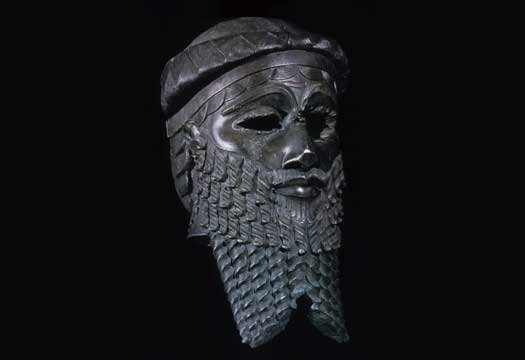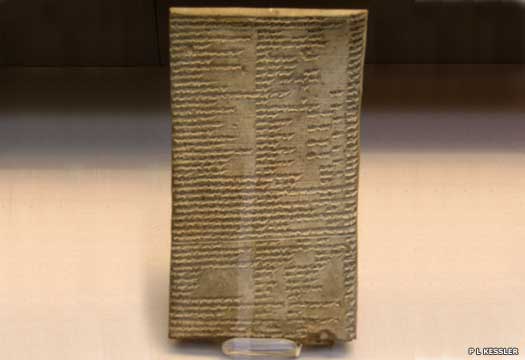
| AGADE / AKKAD City State of Agade / Akkad :
Situated to the immediate north of Sumer, the Akkadians were of Semitic origin. The people of Mari a little to the north were probably of the same stock. Their language is first attested in about 2800 BC, and it survived alongside Sumerian until about 1800 BC, when the latter died out from everyday use.
Under the rule of Sargon I, the city state of Agade (which was the Sumerian name for the city in the region of Akkad, known in the Bible as Accad) rose for a brief time to be a powerful empire, becoming one of the first to unify the entire south-central Mesopotamian region. The city was probably located on the west bank of the Euphrates in central Mesopotamia, between Sippar and Kish. Its ruins have yet to be found. Although the Sumerian king list claims that Sargon built Agade, it is mentioned in the reigns of more than one of his predecessors, such as En-cakanca-ana of Uruk and Lugalzaggesi of Uruk, so Sargon was probably just responsible for re-building and expanding it.
According to the king list, a total of twelve kings ruled for 197 years, once (in one dynasty) in Agade (List 1), or eleven kings ruled for 181 years, or nine kings ruled for 161 / 177 years (List 2). This is the fifteenth set of entries on the list comprising kings 82-92. Here, List 1 is primarily used, backed up by List 2 (see Sumer for details). Note that older dating systems place Sargon at circa 3000 BC, but this appears to be an increasingly inaccurate estimate.
(Additional information by Ras Feqade.)
c.2440 BC :
En-cakanca-ana of Uruk conquers Agade, claiming hegemony over all of Sumer.
fl c.2350 BC :
Alusarsid / Urumus : Existence and location uncertain.
Alusarsid
is an early king of Agade who 'subdued Elam and Barahs (Barahsi?)'.
This is contemporary with the reign of Lugalzaggesi of Umma.
An element of more recent scholarly thinking equates him with
Rimush, the successor of Sargon of the Akkadian empire, below,
suggesting that his name has been misread until now. Alusarsid
has also been placed in 'Kis' or Kish as ruler there, showing
a great deal of ambiguity for this ruler's location and very existence.
Akkadian Empire :
Sargon created an Akkadian empire which truly unified Sumer and Akkad administratively for the first time ever. However, there were problems, not least because each of the former independent city states inside the empire resented the imposition of outside control, and revolts were common.
(Additional information by Ras Feqade.)
c.2334 - 2279 BC :
Sargon I the Great : Ruled for 56/55/54 years. Born c.2370.
Sargon the Great, the warrior king of apparently humble origins, unified Sumer for the first time in recorded history through a series of campaigns and the defeat of the current holder of Sumer's equivalent of a high kingship He defeats and captures Lugalzaggesi of Uruk and Umma, claiming the empire and the kingship for his own. Expanding his territory he defeats Lagash and Kazallu, invades Syria and the Levant four times, campaigns against the Gutians, the Hatti, and Marhashi, and creates a realm that stretches from Anatolia and the Mediterranean, covering the Amorites (Martu) west of the Euphrates, up to Apum in northern Mesopotamia, and over to Elam in the east and Oman in the south. It is possibly he who is responsible for the destruction of Mari. He also controls Mesopotamia to the north of Akkad, where the early Assyrian civilisation is achieving a level of sophistication of its own, and is enamoured of foreign goods, including those traded from the Indus Valley.
c.2278 - 2270 BC :
Rimush / Rimuc : Son. Ruled for 9/7/15 years.
Rimush re-conquers a rebellious Elam and Marhashi (in modern central Iran), and fights hard to retain the empire, although he is apparently assassinated. An element of more recent scholarly thinking regards Rimush as being the same as Alusarsid, the minor ruler of early, pre-Sargon Agade, although he is still placed after Sargon in the reignal list.
c.2269 - 2255 BC :
Manishtushu / Man-icticcu : Older (or younger) brother. Ruled for 15/7 years.
Manishtushu renovates the Temple of Ishtar, and fights a sea battle against thirty-two kings who gather against him. Like his brother, he also seems to die through assassination.
c.2254 - 2218 BC :
Naram-Sin / Naram-Suen : Son. Ruled for 56 years. Claimed god-like status.
Facing revolts from the start of his reign, Naram-Sin conquers Ebla in Syria, defeats a coalition led by Kish, another coalition led by Uruk (which when combined includes all the major cities of Mesopotamia), and also attacks Nippur and the Hatti. He places his son, Sharkalisharri, in control of Nippur and conquers the Lullabi in the north.
With Agade growing steadily weaker, Elam and Marhashi declare their independence (although they are re-conquered for a time). It is possible that Uruk is a key player in the revolts. In a more peaceful moment, Naram-Sin is able to marry his daughter, Tar'am-Agade, to the king of Urkesh which is perhaps located on the very edge of Akkadian-controlled territory in the north.
c.2217 - 2193 BC :
Sharkalisharri / Car-kali-carri : Son. Ruled for 25/24/29 years. m dau of ruler of Marhashi.
c.2210 BC :
Marhashi overruns Elam for a time, and unites eastern efforts in fighting against the Akkadian Empire. A battle is fought near Akshak, at the confluence of the Diyala and Tigris rivers between the two states. One of the Marhashi ruler's daughters is married to Sharkalisharri of Agade or his son, perhaps as a consequence of the battle, and as a sign of renewed ties of peace.
c.2193 BC :
The Gutians sweep through southern Mesopotamia and overthrow both Elam and the Akkadian empire, either during Naram-Sin's reign or that of his son, ending Sumerian/Akkadian domination of the region. The Akkadians survive but their power is minimal, their decline helped along by a series of very brief, non-dynastic rulers. Both Sumer and Egypt endure a short (climate-induced) dark age at this time, and very little is known about Agade itself until around 2100 BC.
The king list now states: 'Who was king? Who was not king? Igigi the king; Nanum, the king; Imi the king; Elulu, the king - the four of them were kings but reigned only three years' see below). Civil war apparently grips the city of Agade. In the north the Hurrians arise as a notably separate group which begins to dominate the upper Tigris Valley and the upper Euphrates.
Akkadian State (Agade) :
A rump Akkadian state survived the Gutian invasion and managed to limp on for a further half a century. The Gutians presented themselves as the true inheritors of the Akkadian Empire. In the now freed former Akkadian territories of Syria and Canaan, the Khirbet Kerakware culture emerged.
c.2192 - ? BC :
Igigi : Ruled for ? years.
Nanium / Imi : Ruled for ? years.
Imi / Nanûm : Ruled for ? years.
Elul-dan / Elulu / Ilulu : Ruled for ? years.
c.2190 BC :
Dudu, probably the son of Sharkalisharri, takes control of Agade and restores a semblance of stability.
Cuneiform tablets rarely survive intact, so this Akkadian example which translates a hymn to the goddess Ishtar from Sumerian is especially valuable c.2189 - 2169 BC :
Dudu : Ruled for 21 years.
c.2168 - 2154 BC :
Shu-Turul / Shudurul / Cu-Durul : Son. Ruled for 15/18 years.
c.2154 BC :
The Akkadian kingdom collapses and the city is reputedly destroyed, thoroughly, by the occupying Gutians. The king list says it is destroyed by Urnigin of Uruk and the kingship carried off there, but this may instead be a reference to Uruk regaining the advantage in terms of power. The final Akkadians could be contemporaries of the kings of Uruk, and both are smashed by the Gutian hordes who are themselves expelled from Sumer in circa 2120 BC by a later king of Uruk.
c.1897 BC :
Akkad re-emerges as an Amorite city state within the Babylonian empire, forming the capital of its northern division.
Source :
https://www.historyfiles.co.uk/ |

